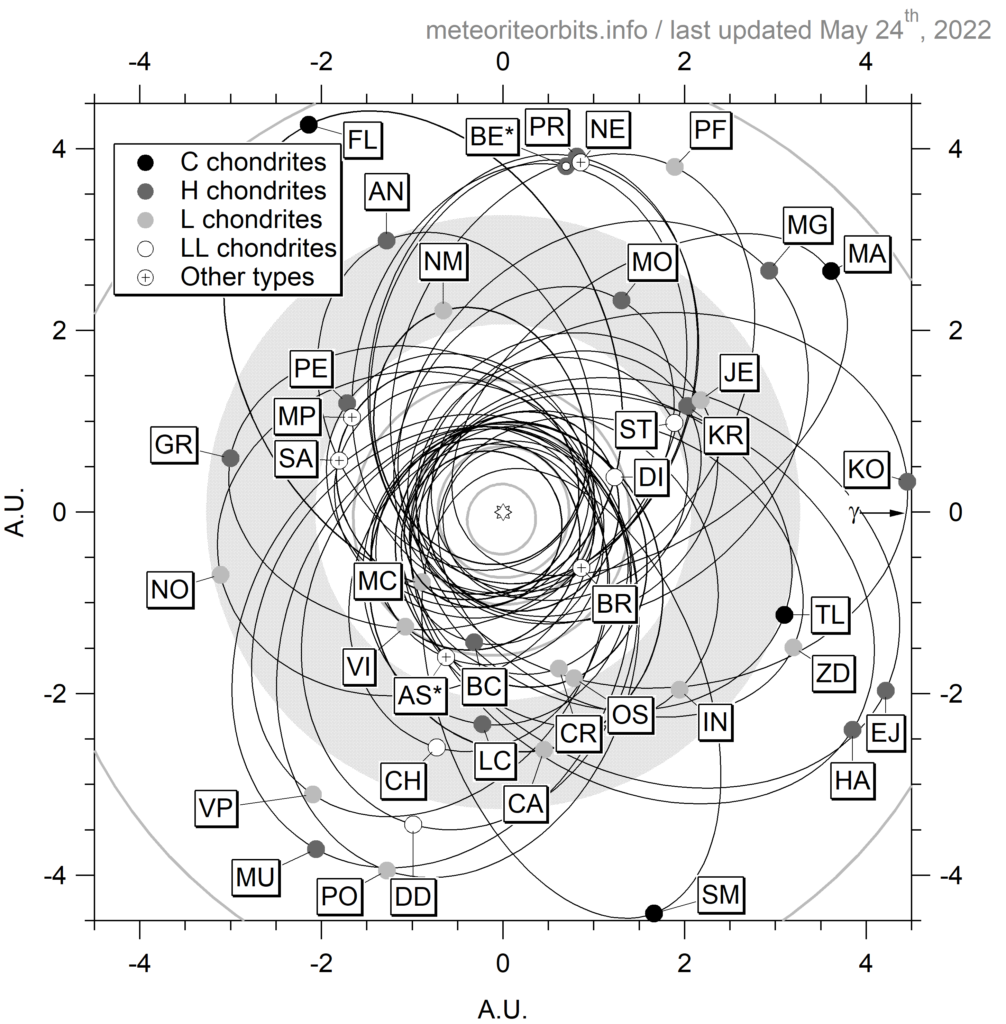On this site, you can find a couple of up-to date plots showing the history and the properties of meteorites with orbits. Feel free to use these plots for outreach and conference talks, as long as you attribute them properly to this site (e.g., “Provided by meteoriteorbits.info” – you can remove the pseudo-watermark in the plots if you attribute otherwise), but do not use them for scientific publications without my written consent. Note that these plots are not (yet) automatically generated and might thus take some time to update. Compare date given on plot in case of doubt.

During the 20th century, the addition of new meteorites with photographic orbits happened at a rate of about once per decade. In the early 21st century, there has been a notable increase, with up to four meteorites per year (Fig. 1). Note that this figure is incomplete (at least for the last few years), as some meteorite falls for which orbits have been determined have not yet been published.

The orbits of the known meteorites with photographic orbits show no preferred direction. A few meteorites have very similar orbits, e.g. Pribram and Neuschwanstein, and were thus suggested – despite their different types – to be part of a “meteoroid stream” (Spurný et al., 2003). As shown in Fig. 2, a third meteorite, Benesov, has a quite similar orbit as well. Except for five (Almahata Sitta, Bunburra Rockhole, Buzzard Coulee, Dishchii’bikoh and Sariçiçek), all meteoroids have orbits which cross into the asteroid belt (although keep in mind that this is a projection, and some of the orbits are strongly inclined to the ecliptic, so not all orbits which seem to cross through the asteroid belt in Fig. 2 necessarily pass through regions with many asteroids in them). It is also notable that none of the orbits crosses the orbit of Jupiter.

In the eccentricity vs. semi-major axis space (Fig. 3), obviously all meteorite orbits must have values which allow them to cross the Earth’s orbit (i.e., they must be above the blue “Earth-crossers” line). With the exception of Bunburra Rockhole and Dishchii’bikoh, all of them are also Mars-crossers, but only five of them (Bunburra Rockhole, Annama, Zd’ár nad Sázavou, Maribo and Sutter’s Mill) cross the orbit of Venus. Most meteorite orbits actually have their perihelia right at the Earth’s orbit – taken together, these observations seem to suggest that the Earth – and Venus – are relatively efficient at removing meteoroids in crossing orbits. The orbits also provide a good match to the region in which fireballs with a non-zero terminal mass – those which we can expect to have dropped meteorites, even if they have not been found – are plotting (“Canadian meteors”, star symbols in Fig. 3; Halliday et al., 1996). Also shown are the “meter-scale” bolides reported by Brown et al. (2016; cross symbols), which show a similar distribution, although there seems to be a pronounced mis-match for a < 1 AU. Five meteorites, the CM2 chondrites Sutter’s Mill and Maribo (for the latter, only in the preferred solution of Spurný et al., 2013), the C1-ungrouped chondrite Flensburg, and the two H-chondrites Hamburg and Ejby, have an orbit with a Tisserand parameter between 2 and 3, which is a defining characteristic of Jupiter family comets (JFCs; see also Haack et al., 2011; Meier, 2014). At least in the case of the two H-chondrites, this is probably due to excitation (increase in eccentricity) while in the 5:2 resonance, and not because they are directly related to JFCs.
A broad review of the topic of meteorites with orbits is given by Borovička et al. (2015).
References
- Borovička J., Spurný P., Brown P., 2015. Small Near-Earth Asteroids as a Source of Meteorites. In: Asteroids IV (Edited by Patrick Michel; Francesca E. DeMeo; William F. Bottke Jr.). University of Arizona Press, Tuscon AZ, USA (785 pp.). (A very similar version of this chapter is available as arXiv preprint)
- Brown P., Wiegert P., Clark D., Tagliaferri E., 2016. Orbital and physical characteristics of meter-scale impactors from airburst observations. Icarus 266:96-111.
- Spurný P., Oberst J., and Heinlein D., 2003. Photographic observations of Neuschwanstein, a second meteorite from the orbit of the Přibram chondrite. Nature 434:151-153.
- Spurný P, Borovička J., Haack H., Singer W., Jobse K., and Keuer D., 2013. Trajectory and orbit of the Maribo CM2 meteorite from optical, photoelectric and radar records. Meteoroids 2013 Conference, abstract #111.
- Haack H., Michelsen R., Stober G., Keuer D., Singer W. and Williams I., 2011. CM Chondrites from Comets? — New Constraints from the Orbit of the Maribo CM Chondrite Fall. Workshop on Formation of the First Solids in the Solar System, held November 7-9, 2011 in Kauai, Hawaii. Abstract #9100.
- Halliday I., Griffin A. A., Blackwell A. T., 1996. Detailed data for 259 fireballs from the Canadian camera network and inferences concerning the influx of large meteoroids. Meteoritics & Planetary Science 31, 185-217.
- Meier, M. M. M., 2014. Are CM, CI chondrites from Jupiter Family Comets? 77th Annual Meteoritical Society Meeting, abstract #5009.
